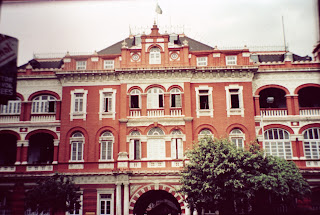Much has been lost in Kolkata (till 2000 known much more widely as Calcutta, the first capital of British India) over the last one hundred years or so; but much still remains. Thanks to the personal interest taken by Shri Somen Mitra, Additional Director General of Police (West Bengal Police), the Governors' House in Barrackpore near Kolkata has received a new lease of life. Slowly, the classical architecture with the Doric facade is emerging out of the dust and shadows of years of neglect.
Barrackpore can be easily reached by a short drive of less than an hour from Kolkata along the Barrackpore Trunk Road, turning left at Chiria More, or four-way crossing, towards the Barrackpore Cantonment; the main sites are to the left shortly beyond the small Lady Hardinge Bridge. One may go in a shorter time of about half an hour from Sealdah Railway station by suburban train up to Barrackpore; but such trains tend to be quite crowded.
The history of the governor's house at Barrackpore goes back to the life and times of Lord Wellesley, governor-general at the Fort William in Calcutta in 1798. Since then it has served as the country residence of successive Governors-general and Viceroys of India under the British colonial rule, till India achieved Independence in 1947.
The history of the governor's house at Barrackpore goes back to the life and times of Lord Wellesley, governor-general at the Fort William in Calcutta in 1798. Since then it has served as the country residence of successive Governors-general and Viceroys of India under the British colonial rule, till India achieved Independence in 1947.
It was in the adjoining military cantonment at Barrackpore, that Mangal Pandey, a sepoy in the Native Infantry, lit the lamp of revolt against the British military establishment, that saw its rise into the Sepoy Mutiny of 1857 (also known as India's first War of Independence) against British misrule in India.
Barrackpore is a short journey by local suburban train (best over a week-end) or by car from Kolkata. After passing "Lat Bagan" (literally, the governor's garden) at Barrackpore, one would have get permission from the local Directorate of Police Training and proceed to the Lady Hardinge Bridge a short distance from the "White Tiger Statue". The small museum in the basement of the Governor's House is a "must see" for local history - indeed for modern Indian history.













